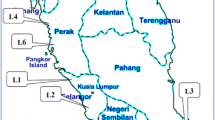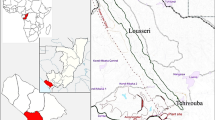Abstract
Instrumental neutron activation analysis (INAA) was used for the determination of major, minor and trace elements in samples of bottom sediments of the inflows of the Selenga river basin to assess the impact of the contamination from the industrial complex Erdenet and other industrial enterprises in Mongolia. A total of 42 elements (Na, Mg, Cl, K, Ca, Al, Sc, Ti, V, Cr, Mn, Fe, Co, Ni, Cu, Zn, As, Se, Br, Sr, Rb, Sr, Zr, Nb, Sb, Cs, Ba, La, Ce, Nd, Sm, Eu, Tb, Dy, Tm, Hf, Ta, W, Au, Hg, Th, and U) was determined by combination of conventional and epithermal neutron activation analysis at the IBR-2 reactor, FLNP JINR, Dubna. For the first time such a large set of elements was used for characterization of the bottom sediments as accumulating media which may reflect industrial contamination of the water basin. The concentrations of heavy metals and other trace elements in the samples from three inflows of the Selenga river basin were compared with data from the previous studies. It was shown that the industrial zone of the Erdenet Mining Corporation (EMC) and gold mining zone Zaamar are the sources of strong environmental contamination. The concentrations of Cu and Sb determined in sediment samples of the River Khangal and Govil near the EMC exceed average crustal rock and soil values by factors of 50 and 15, respectively. In the area of the gold mining zone Zaamar concentrations of Au, As, and Sb exceed crustal rock and soil values by factors of 4, 25, and 6, respectively. The relatively high levels of As, V, Zn, V, and Sr in the sediments of the studied rivers are obviously due to the discharges of untreated wastewater of desalination plant, electrical power station, textile industry and mining activities as well as domestic wastewater.
Similar content being viewed by others
References
United States Environmental Protection Agency (USEPA), Water quality monitoring for Coffee Creek (Porter County. Indiana). http://www.USEPA/Research/Research.htm.modecode62-28-00-00. Cited September 29, 2006.
T. Hart, “Uptake of trace metals by sediments and suspended particulates: A review,” Hydrobiologia 91, 299–313 (1982).
S. Suthar, A. K. Nema, M. Chabukdhara, et al., “Assessment of metals in water and sediments of Hindon river. India impact of industrial and urban discharges,” J. Hazard. Mater. 171, 1088–1095 (2009).
K. G. Bhattacharyya and N. Kapil, “Impact of urbanization on the quality of water in a natural reservoir: A case study with deeper beel in Guwahati city. India,” Water Environ. J. 24, 83–96 (2010).
N. Petrova, V. Uvarova, and T. A. Butakova, “Effect of mining of nonmetallic construction materials on aquatic animals in the Irtysh river channel,” Tr. Gos-NIORK, No. 305, 135–145 (1989).
V. V. Rusanov and V. M. Volkova, “Environmental assessment of the effect of hydraulic excavation on water bodies,” in Dredging Operations and the Problems of Fish Reserve Protection and the Environment in Water Bodies Used for Fishery (KaspNIRK, Astrakhan, 1984), pp. 151–152 [in Russian].
S. Zandaryaa, U. Borhculuun, and Sh. Munkhtuya, “Reserves, consumption and contamination of ground-water in Ulaanbaatar. Mongolia,” Atlas Urban Geol. 14, 445–488 (2003).
L. Janchivdorj, “Gold mining and water use,” in Geological Issues in Mongolia (Inst. of Geology, Mongolian Academy of Sciences, 2006), No. 6.
D. Banzragch and Hiroaki Ishiga, “Geochemical evaluation of present-day Tuul river sediments, Ulaanbaatar basin. Mongolia,” J. Environ. Monitoring Assessm. 185, 2869–2881 (2013).
D. F. Pavlov et al., “Toxicity assessment of bottom sediments in watercourses in Selenga river basin on the territory of Mongolia,” J. Water Res. 35, 92–96 (2008).
D. F. Pavlov et al., “Levels of heavy metals and organochlorine pesticides and toxicity assessment of bottom sediments in the Selenga river basin in Mongolia,” in Proceedings of the International Conference, Ulan-Ude, Ulan-bator (Buryat Scientific Center, 2004), Vol. 2, pp. 91–92.
M. N. Ambulkar et al., Appl. Rad. Isotopes. 43, 1171 (1992).
G. Revel, Analyse par activation (Techniques de L’Ingenieur, 1999) [in French].
B. Dupre, J. Gaillardet, and C. J. Allégre, Geochim. Cosmochim. Acta 60, 1301–1321 (1996).
Montsame New Agency, Mongolia (Foreign Service Office of Montsame New Agency, 2006), p. 80.
W. Dallas, “An assessment of environmental impact issues and issues relating to gold mining in the Zaamar region,” in Mongolia: Executive Summary (World Bank, Washington DC, 1999), p. 13.
M. V. Frontasyeva and E. Steinnes, “Epitermal neutron activation analysis for studying the environment,” in Proceedings of the International Symposium on Harmonization of Health Relate Environmental Mesurements Using Muclear and Isotopic Techniques, Hyderabad, India, Nov. 4–7, 1996 (IAEA, 1997), pp. 301–311.
M. V. Frontasyeva and S. S. Pavlov, “NAA for Life and Sciences” PEPAN, 2011, vol. 42, No. 2, p. 332–378.
T. M. Ostrovnaya and L. S. Nefedyeva, et al., “Software for NAA on the basis of relative and absolute methods nuclear data base, in Activation Analysis in Environment Protection, JINR D14-93-325 (Dubna, 1993), pp. 319–326.
Y.-H. Li and J. E. Schoonmaker, “Chemical composition and mineralogy of marine sediments,” in Treatise on Geochemistry, Ed. by H. D. Holland and K. K. Turekin (Elsevier, Amsterdam, 2003), Vol. 7, pp. 1–35.
P. D. Gunin, A. K. Yevdokimova, et al., Social and Ecological Problems of the Mongolian Ethnic Community on Urbanized Territories (Ulaanbaatar, Moscow, 2003), pp. 61–95.
G. Ganbold et al., “Assessment of hazardous impact on the pastured animals of non-ferrous industry in the town of Erdenet, Mongolia,” JINR Commun. E18-2006-176 (Dubna, 2006).
R. Baigalmaa, D. Bolortuya, et al., “Pollution of soil, plant and water in around Erdenet city,” in Proceedings of the International Conference on Contemporary Physics ICCP-IV (Ulaanbaatar, Mongolia, 2007), pp. 81–83.
D. F. Pavlov, I. I. Tomilina, et al., “The levels of heavy metals and toxicity of bottom sediments of water basin of river Selenga. Aquatic ecosystems of river Selenga basin,” in Proceedings of the Joint Russian-Mongolian Complex Biological Expedition of RAS and ASM (IEE RAS, Moscow, 2009), pp. 326–345.
B. Byambaa and Y. Todo, “Technological impact of placer gold mine on water quality: Case of Tuul river valley in the Zaamar goldfield, Mongolia,” J. World Acad. Sci. Eng. Technol. 51, 168–171 (2011).
J. G. Bazarova, B. G. Bazarov, et al., “Hydrochemical characteristics of Selenge river and its tributaries on the territory of Mongolia,” Mongol. J. Biol. Sci. 2, 39–42 (2004).
R. Baigalmaa, D. Bolortuya, et al., “Pollution of soil, plant and water in around Erdenet city,” in Proceedings of the International Conference on Contemporary Physics ICCP-IV (Ulaanbaatar, Mongolia, 2007), pp. 81–83.
S. Word, K. Esbensen, and P. Geladi, Chemom. Intell. Lab. Syst. 2, 37 (1987).
Author information
Authors and Affiliations
Additional information
The article is published in the original.
Rights and permissions
About this article
Cite this article
Baljinnyam, N., Frontasyeva, M.V. & Aleksiayenak, Y.V. INAA for determination of trace elements in bottom sediments of the Selenga river basin in Mongolia. Phys. Part. Nuclei Lett. 11, 199–208 (2014). https://doi.org/10.1134/S1547477114020149
Published:
Issue Date:
DOI: https://doi.org/10.1134/S1547477114020149




